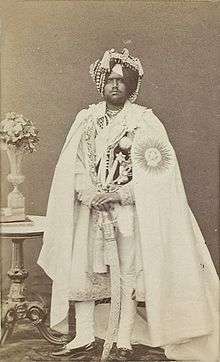Patiala State
Patiala State was a self-governing princely state of the British Empire in India, and one of the Phulkian States, that acceded to the Union of India upon Indian independence and partition.
| Patiala State | |||||||
|---|---|---|---|---|---|---|---|
| Princely State of British India | |||||||
| 1763–1948 | |||||||
 Flag
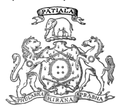 Coat of arms
| |||||||
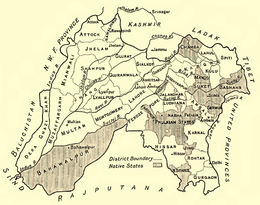 Patiala State in a 1911 map of Punjab | |||||||
| Capital | Patiala | ||||||
| Population | |||||||
• 1931 | 1,625,000 | ||||||
| History | |||||||
• Established | 1763 | ||||||
• Independence of India | 1948 | ||||||
| |||||||
| Today part of | Punjab Haryana | ||||||
Etymology
The state's name came from the name of its principal city and capital, Patiala, which itself comes from the roots pati and ala. The former is Urdu for a "strip of land" and 'ala' comes from the name of the founder of the city and Patiala state, Ala Singh, thus meaning ‘the land of Ala Singh’.[1]
Brief history
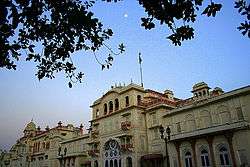
The office of Maharaja became hereditary among the descendants of Ala Singh until Phul, the Sikh ancestor of the dynasty, which came to rule over Patiala, Jind, and Nabha.
Early history
The history of Patiala state starts off with the ancestor of the Sikh Patiala Royal House, Mohan Singh being harassed by neighbouring Bhullar and Dhaliwal farmers . They would not allow Mohan to settle there. He was a follower of Guru Hargobind Sahib and the Guru appealed on behalf of Mohan but to no avail. The result was an armed struggle and the Bhullars and Dhaliwals were defeated by the Guru's men, which allowed Mohan to establish the Village of Meharaj in 1627.[2]
Battle of Mehraj
Mohan Singh fought against the Mughals at the Battle of Mehraj 1631 on the side of Guru Hargobind Sahib. Mohan Singh and his eldest son Rup Chand were later killed in a fight against the Bhatti's (a tribe who also claim to be the descendants of Rawal Jaisal of Jaisalmer, but also an enemy of the Phulkians). Kala, Mohan's younger son succeeded the "chaudriyat", and was guardian to Rup Chand's sons Phul and Sandali.
Phul
When Kala Sidhu died, Phul formed his own village (Phul), five miles from Meharaj (under the blessings of Sikh Guru's) in 1663. Nabha and Jind trace their ancestry to the devout Sikh Phul. It was one of the first Sikh Kingdoms of Punjab to be formed. Apparently the appellation of dynasty "Phulkian" is derived from their common founder. One of his sons, Chota Ram, was baptised and blessed by Guru Gobind Singh. His son Ala Singh assumed the leadership in 1714 when Banda Bahadur was engaged in the fierce battle against the Mughals. A man with vision and courage, Ala Singh's general, Gurbaksh Singh Kaleka, carved out an independent principality from a Zamindari of 30 villages. Under his successors, it expanded into a large state, touching the Shivaliks in north, Rajasthan in the south and upper courses of the Yamuna and Sutlej rivers while confronting the most trying and challenging circumstances.
Baba Ala Singh
In the middle of the eighteenth century, Baba Ala Singh, unlike many of his contemporaries, displayed tremendous shrewdness in dealing with the Marathas and Afghans, and successfully established a state which he had started building up from its nucleus Barnala. He became traitor to the Sikhs, who made him a Sardar from a peasant and fought on the side of Ahmad Shah Abdali against the Sikhs .
Qila Mubarak

In 1763 Baba Ala Singh laid the foundation of the Patiala fort known as Qila Mubarak, around which the present city of Patiala developed. After the Third Battle of Panipat in 1761 in which the Marathas were defeated, the writ of the Afghans prevailed throughout Punjab. It is at this stage that the rulers of Patiala began to acquire ensigns of royalty. Ahmad Shah Abdali bestowed upon Ala Singh furm and banner, and the title of Maharaja of Patiala. After his death, his grandson Amar Singh succeeded and received the title of Raja-I-Rajaan. He was also allowed to strike coins.
Treaty with the British
After forty years of ceaseless struggle with the Marathas and Afghans, the borders of the Patiala state witnessed the blazing trails of Ranjit Singh in the north and of the British in the east. Bestowed with the grit and instinct of survival, making self-preservation a priority the Raja of Patiala entered into a treaty with the British against Ranjit Singh in 1808, thus becoming collaborators in the empire building process of the British in the sub-continent of India. The subsequent rulers of Patiala, such as Karam Singh, Narinder Singh, Mahendra Singh, Rajinder Singh, Bhupinder Singh, and Yadvindra Singh were parties to a subsidiary alliance and were heavily influenced by the British, but retained the internal government of their state.
Maharaja Bhupinder Singh
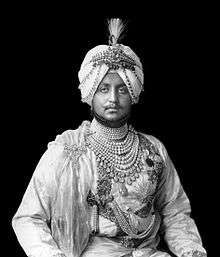
Maharaja Bhupinder Singh, who reigned from 1900 to 1938, gave Patiala a prominent place on the political map of India and also in the field of international sports. In the game of Polo, Patiala had the World's best Polo Back, General Chanda Singh, who later went on to play for England and Spain on the requests of King Edward VII and King Alfonso of Spain, winning both Kings a prestigious Polo Cup. The Maharaja was also fond of dogs, and he and the Maharaja Ranbir Singh of Jind were equally interested in a range of dog breeds. His son Maharaja Yadavindra Singh was the first Indian prince to sign the Instrument of Accession to the new Union of India, thus facilitating the process of national integration after the Partition of India and the departure of the British in August 1947. In recognition of his services, he was appointed as Rajpramukh of the newly established Patiala and East Punjab States Union (PEPSU), from its founding in 1948 until its merger with the Punjab Province in 1956. The downtown area of Patiala is called Adalat Bazaar, which means 'the court corridor', because this was used as the administrative building by one of the caretaker rulers, before Maharaja Bhupinder Singh had reached the age of majority. Rajmata Mohinder Kaur was the oldest member of the family till 2017, and the present head is Amarinder Singh, current chief minister of Punjab.
Rulers

The rulers of Patiala bore the title 'Maharaja-e Rajgan' from 1810 onward.[3]
Maharajas
- 29 Mar 1761 – 22 August 1765: Ala Singh (b. 1691 – d. 1765)
- 22 Aug 1765 – 1767: Amar Singh (b. 1748 – d. 1781)
Raja-e Rajgan
- 1767 – 5 February 1781: Amar Singh (s.a.)
- Feb 1781 – 1810: Sahib Singh (b. 1774 – d. 1813)
Maharaja-e Rajgan
- 1810 – 26 March 1813: Sahib Singh (s. a.)
- 26 Mar 1813 – 23 December 1845: Karam Singh (b. 1797 – d. 1845)
- 26 Mar 1813 – 1823: Maharani Aus Kaur (f) – Regent (b. 1772 – d. af.1823)
- 23 Dec 1845 – 13 November 1862: Narendra Singh (b. 1823 – d. 1862) (from 25 June 1861 Sir Narendra Singh)
- 13 Nov 1862 – 14 April 1876: Mahendra Singh (b. 1852 – d. 1876) (from 28 May 1870 Sir Mahendra Singh)
- 13 Nov 1862 – 26 February 1870: Jagdish Singh (Regent, chairman of regency council)
- 14 Apr 1876 – 9 November 1900: Rajinder Singh (b. 1872 – d. 1900) (from 21 May 1898 Sir Rajendra Singh)
- 14 April 1876 – Oct 1890: Sir Deva Singh (Regent) (b. 1834 – d. 1890) (chairman of regency council)
- 9 November 1900 – 23 March 1938: Bhupinder Singh (b. 1891 – d. 1938) (from 12 December 1911 Sir Bhupindra Singh)
- 9 November 1900 – 3 November 1910: Sardar Gurmukh Singh – (Regent, chairman of regency council)
- 23 Mar 1938 – 15 August 1947: Yadavindra Singh (b. 1913 – d. 1974) (from 1 January 1942 Sir Yadavindra Singh)
References
- "The History of Patiala | Patiala". www.totalpunjab.com. Retrieved 24 March 2020.
- A History of Sikh Misals, Dr Bhagat Singh
- Princely states of India
